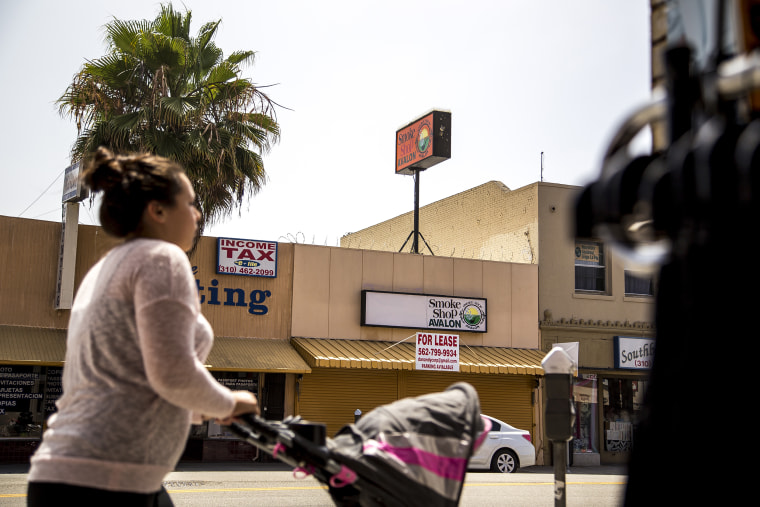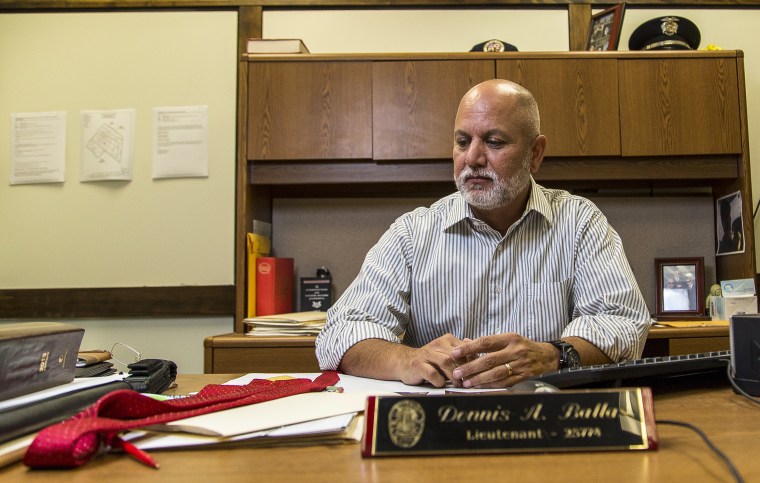LOS ANGELES -- Graffiti-tagged buildings, barricaded doors and iron-barred windows mark nearly every block of Avalon Boulevard as it cuts through the predominantly Hispanic neighborhood of Wilmington, 20 miles south of downtown Los Angeles.
The streets are lined with small mom-and-pop shops – clothing stores, a piñata shop, garages and small, family-owned restaurants – and a clutch of illegal medical marijuana dispensaries, some located within feet of each other.
Other nearby dispensaries are shuttered with signs announcing ‘closed,’ ‘for lease’ and ‘for rent’ – the result of the city’s most recent attempts to close the door on L.A.’s robust illegal medical marijuana industry. But when one dispensary closes, it usually opens somewhere else, police say.
Passed by California voters nearly two decades ago, but absent statewide regulation, the legalization of medical marijuana has spawned a vast network of illegal dispensaries and wide disparities over how businesses are monitored across the state– if they are at all.
Click Here to See All of News21's "America's Weed Rush" Project
In some parts of California, law enforcement officials have aggressively pushed back, raiding growers and dispensaries in a never-ending effort to control the industry.
But in Los Angeles, according to a recent UCLA study and News21 interviews with law enforcement, at least three out of four dispensaries are illegal, operating without approval or regulation from the city. And they’re concentrated in poor and minority neighborhoods like Wilmington, where police have other priorities than playing whack-a-mole with weed stores.
“Even if I had 10,000 more officers, would I have them tackling marijuana?” said Lt. Dennis Ballas of the Los Angeles Police Department. “Because we have to prioritize the needs of us as an agency to match the needs of the community. We also go public safety first.”
California voters passed the Compassionate Use Act in 1996, allowing state residents with written doctors’ recommendations to cultivate, possess and ingest marijuana. The state law allows patients to possess eight ounces of marijuana and cultivate 12 immature or six mature plants. It also allows doctors to recommend as much marijuana they want.
But the Compassionate Use Act didn’t determine how the state’s government would regulate the industry. Instead, it tasked the state’s local governments with the job.
California has 482 cities and 58 counties, all with the power to govern their own medical marijuana industries. The methods they have chosen vary. Some local governments have rules limiting the number of dispensaries and where they can open. Others passed ordinances banning all marijuana cultivation.
"It's been the Wild West," said John Lee, who runs a group called Americans for Policy Reform that’s trying to get full legalization of marijuana on California’s November 2016 ballot. "Each municipality is having to deal with it, and spend money and resources. The examples are significant."
The city of Los Angeles did not establish regulations until two years ago, 17 years after medical marijuana was legalized. In 2013, voters fed up with an unfettered industry passed Proposition D, which banned medical dispensaries except for those that were operating legally prior to 2007 and had already registered with the city.

The Los Angeles City Attorney’s Office has said that just 134 medical marijuana dispensaries are eligible to operate legally in the city. But hundreds more are in business illegally – at least 75 percent of all the city’s dispensaries, according to a survey by the University of California, Los Angeles, and News21 interviews with LAPD.
“Overnight, it was just one, and then the next thing you know there’s two, and then the next thing you know there’s three,” said LAPD Officer Rogelio Perez, senior lead officer for the department's Harbor Division.
UCLA researchers looked at the city’s medical marijuana dispensaries and found that the highest concentrations are in black and Hispanic neighborhoods with lower household incomes than the citywide average.
According to UCLA’s research, in 2007 there were about two dispensaries in Wilmington and the neighborhoods of South L.A., Southeast L.A., San Pedro, Harbor Gateway. Now nearly 40 are operating in those communities alone.
By contrast, Pacific Palisades and Beverly Crest, two of the three wealthiest neighborhoods in L.A., did not have a single dispensary open during the period covered by the study. As of 2014, six of the city’s 10 highest-income neighborhoods had no dispensaries, according to a News21 analysis of the UCLA data.
“People living in these areas where there have been high densities of outlets, if they’re middle to higher income, they have a lot more social capital,” said Bridget Freisthler, UCLA’s lead researcher. “So they work together and they decide that this is a problem and they’re very vocal about it.
“Areas that are lower income and more disadvantaged generally don’t have the same amount of relationships with other people in the neighborhood, or the social capital there,” she said. “They’re much more concerned about daily living things, and so they might not be able to mobilize in the same way to get dispensaries out of their neighborhoods.”
The lack of citywide enforcement also leads to more crime, police say.
“We’ve seen, at a lot of levels, where the medical marijuana dispensaries are causing harm to the community that surrounds them,” LAPD’s Ballas said.
Among other problems are robberies of dispensaries because they operate in cash. A dispensary security guard in San Bernardino was shot and killed in February.
Even when dispensaries are shut down by the city, they reopen under different names and in new locations. Carlos Amaro, a business owner in Wilmington, said he was offered between $6,000 and $7,000 a month to rent out a piece of land to a grower.

“They’re on this corner, and he (the city attorney) closes them down today, and tomorrow they open on the other corner,” said Yamileth Bolanos, president and founder of the Greater Los Angeles Collective Alliance, an association of legal medical marijuana dispensaries in the city.
She was one of the chief proponents of greater city regulation of the medical marijuana industry leading up to Proposition D in 2013.
“The city attorney says he’s closed down 400 dispensaries since he took office, but he doesn’t talk about the 600 dispensaries that opened up behind the 400 that he closed,” said Bolanos.
A spokesperson for the L.A. City Attorney's Office said the office has targeted illegal dispensaries with civil actions, but said the civil actions take time to resolve.
This report is part of the project titled “America’s Weed Rush,” produced by the Carnegie-Knight News21 initiative, a national investigative reporting project involving top college journalism students across the country and headquartered at the Walter Cronkite School of Journalism and Mass Communication at Arizona State University.